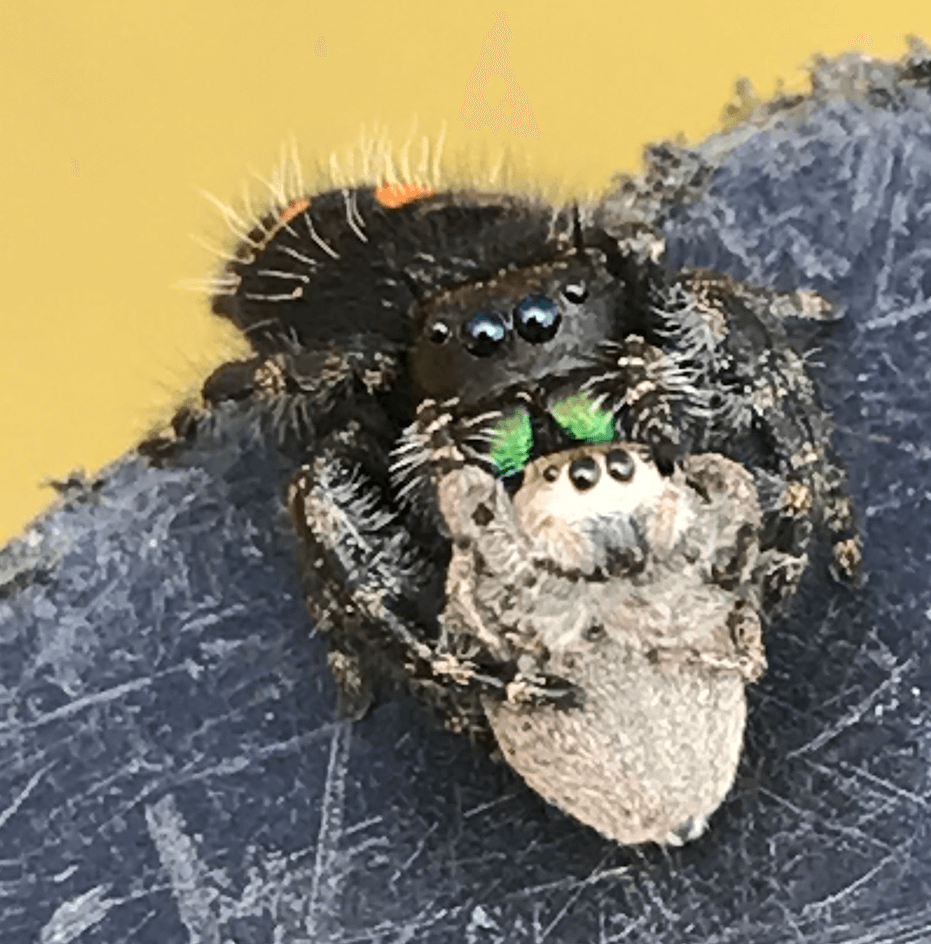Jumping Spider Paddle Battle
By Irmi Willcockson
Broadcast 11.2 & 11.5.2022

The jumping spider paddle battle, right before our eyes! Photo ©Irmi Willcockson.
Listen:
I love paddling my kayak, to get away even for just an hour or two. Sitting in my kayak one morning on a detention pond close to home, I watched a small, tan spider hopping on my paddle. I quickly took a picture, hoping to identify it later. Before I could enjoy watching this new-to-me spider too much, however, another spider—large, black, and hairy—emerged from under my paddle, ran up to the smaller spider, bit it, and started dragging it off! The two looked a bit like they were dancing, with one partner embracing the other from behind. I snapped more pictures before dropping both predator and prey back off on shore.
Back home I did some research and identified both spiders as jumping spiders. Jumping spiders, as their name suggests, frequently hop. Most don’t spin webs and thus must hunt their prey in other ways. And, as in the case of my kayak paddle battle, they can be both predator and prey.
Was what I had witnessed unusual? Not at all, as it turns out. Jumping spiders are known to prey on other spiders, even ones much larger than themselves. Bold or daring jumping spiders are visual hunters who roam open grasslands and woodlands in search of insects and other spiders. Of their eight eyes, the two median forward-facing ones are the largest. The smaller eyes on the top and sides of the head help them detect movement.
I found out that both sexes of daring jumping spiders are about half an inch long, with females a little larger than males. Their compact black body sports orange or white spots on their abdomen, and iridescent green or blue chelicerae, or mouthparts. Males have extra-hairy front legs. Based on my photographs, it is likely that the predator I witnessed was a male.
More research revealed that jumping spiders not only prey on other jumping spiders, but even larger orb weaver spiders. Portia, a well-studied tropical genus of jumping spider, uses both pre-programmed and flexible hunting strategies. When approaching a web, Portia will use its legs to strum or pluck different strands. The precise sequence depends on the species of spider being hunted and the behavior Portia is looking for. Portia wants smaller spiders to approach, so it can bite them. Larger spiders may try to make a meal out of Portia, so calming them while Portia approaches them from behind works better. Yet another strategy is to approach from above, hanging from a silk line, without touching the web at all. In order to attack from above, Portia may even walk around a tree, temporarily losing sight of its intended prey. Scientists did not expect to find these types of flexible hunting strategies from an animal with a brain the size of a pinhead!
So, the jumping spider hunting on my paddle used several strategies to catch its jumping spider prey. Although difficult for me to tell because it happened so unexpectedly, it likely waited until the other spider had turned away. Then, it ran quickly up to it from the side and immediately bit its prey to immobilize it. Because it was exposed on the paddle, it tried retreating with its prey held tightly between its front limbs.
Since I kayak the small pond often, I can get lulled into thinking that I know everything there is to know. Seeing the jumping spider paddle battle reminded me that there is so much to discover every day. Just follow in the footsteps of Mary Oliver, who wrote, “Pay attention. Be astonished. Tell about it.”
Every week since 1991, Field Notes has inquired about Montana’s natural history. Field Notes are written by naturalists, students, and listeners about the puzzle-tree bark, eagle talons, woolly aphids, and giant puffballs of Western, Central and Southwestern Montana and aired weekly on Montana Public Radio.
Click here to read and listen to more Field Notes. Field Notes is available as a podcast! Subscribe on iTunes or wherever you listen to podcasts.
Interested in writing a Field Note? Contact Allison De Jong, Field Notes editor, at adejong [at] montananaturalist [dot] org or 406.327.0405.
Want to learn more about our programs as well as fun natural history facts and seasonal phenology? Sign up for our e-newsletter! You can also become a member and get discounts on our programs as well as free reciprocal admission to 300+ science centers in North America!












